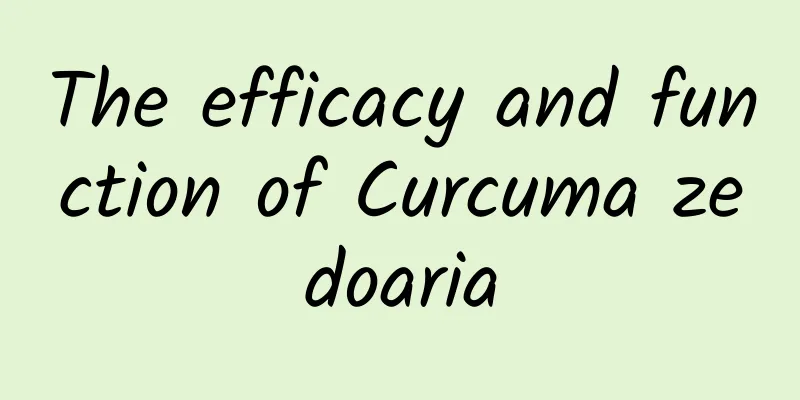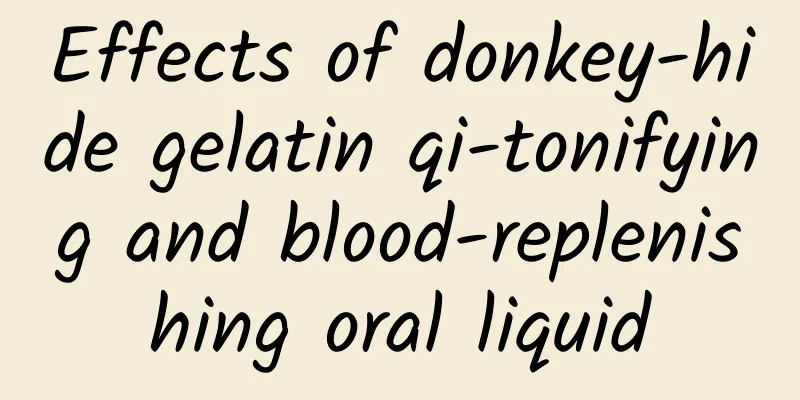The efficacy and function of Curcuma zedoaria

|
Many people are not very clear about the effects and functions of the traditional Chinese medicine Curcuma zedoaria. Let’s take a look below. [Other names] Peng'e Mao (Medicine Properties), Qianyao (Tang Materia Medica), Peng'e Qian (Rihuazi Materia Medica), Guangmao (Zhenzhu Nang), Pengshu (Puji Fang), E Qian (Compendium of Materia Medica), Peng Qian (Benjing Fengyuan), Qiangqi (Shengcao Caoxing Beiyao), Guangshu (Bencao Qiuzhen), Hei Xin Jiang (Lingnan Caiyao Lu), Wenshu (Sichuan Chinese Medicine Records). [Source] It is the rhizome of Curcuma zedoaria , a plant of the ginger family. It can be dug up in autumn and winter, clean off the soil, steam it, dry it in the sun, and remove all hair and impurities. [Original form] Curcuma zedoaria (Introduction to Medicine), also known as mountain turmeric and green ginger. [Habitat distribution] It grows wild in the mountains or in grasslands under forests near villages. Distributed in Fujian, Guangdong, Guangxi, Zhejiang, Taiwan, Yunnan, Sichuan and other places. It is mainly produced in Guangxi and Sichuan. In addition, it is also produced in Fujian, Guangdong, Zhejiang, Yunnan and other places. [Properties] The dry rhizome is oval or spindle-shaped, about 3 to 5 cm long and 1 to 3 cm in diameter. The outer skin is grayish yellow to brownish yellow, slightly wrinkled, with ring-shaped nodes and traces of fibrous roots on the nodes. It is solid and heavy, extremely difficult to break, and the broken surface is gray-brown to yellow-green, horny, shiny, with a yellow-white ring and white veins. It has a slight aroma and tastes slightly bitter and spicy. The best ones are those with uniform size, solid texture and gray-brown cross-section. [Chemical composition] The rhizome contains 1-1.5% volatile oil. The main components of the oil are sesquiterpenes. 【Pharmacological action】 ①Antitumor effect [Preparation] Curcuma zedoaria: Pick out impurities, soak in water until it is thoroughly moistened, place in a steamer and steam thoroughly, take out, slice and dry in the sun. Vinegar Curcuma: Pick out impurities, wash, put in a pot and add vinegar and hot water to cover it, cook over low heat, remove from the pot, dry until 60%, cut into thin slices, and dry in the shade. (For every 100 catties of Curcuma zedoaria, use 10-20 catties of vinegar) 【Nature and flavor】 Bitter, pungent, warm. [entry into meridians] Enters the liver and spleen meridians. 【Functions and indications】Promote qi circulation, resolve blood circulation, eliminate accumulation and relieve pain. It is used to treat bloating and pain in the heart and abdomen, masses, accumulation, indigestion, blood stasis and amenorrhea in women, and pain caused by falls. [Usage and Dosage] For oral use: decocted in water, 1.5 to 3 qian; or made into pills or powder. [Note] People with both Qi and blood deficiency, weak spleen and stomach without stagnation should take it with caution. Pregnant women should not take it. [Additional prescription] ① To treat all kinds of coldness, severe pain in the heart, feeling of death when it occurs, and occasional attacks of heart and stomach pains that have occurred for a long time: 2 liang of Curcuma Atractylodes (boiled in vinegar), 1 liang of Costusroot (simmered). Grind into powder, take half a penny each time, with light vinegar soup. ("Healthy Family Prescription") 【Discussions by various scholars】 ①《Compendium of Materia Medica》: "Peng'e Mao, which was not used in ancient prescriptions, is now the most important medicine for treating accumulation of qi by doctors. It is good to use it together with Jing Sanleng, and is also often used in women's medicine." [Clinical Application] Treatment of cervical cancer: The injection of Curcuma zedoaria was mainly used for local lesion injection, combined with intravenous medication, and a total of 80 cases of early and late stage cervical cancer were observed; among them, the early stage patients took medication for an average of about 9 months, and the late stage patients were treated for an average of about 6 months. Results: 80 cases were clinically cured in the short term (local tumor disappeared, no cancerous tissue was found in pathological examination, 3 vaginal smears were negative, surrounding infiltrated tissue subsided or was controlled, and subjective symptoms disappeared completely or basically disappeared); 15 cases were markedly effective (local tumor subsided by more than 1/2, surrounding infiltrated tissue was controlled, and subjective symptoms improved significantly); 14 cases were effective (local lesions shrank, surrounding infiltrated tissue was controlled, and subjective symptoms improved); and 21 cases were ineffective (subjective symptoms and objective examinations did not change or the condition worsened). It is more effective in treating early-stage cancer (in situ, stage I, stage II) and cauliflower-type and ulcer-type cancer, but less effective in treating late-stage cancer (stage III, stage IV) and recurrence after radiotherapy. Usage: For local injection, use a tonsil syringe, insert the needle into the lesion tissue or the basal layer, and evenly deliver the liquid into the lesion from shallow to deep, without leakage of the liquid. The depth should reach the basal layer of the lesion. It is also best to administer the drug at the same time to some tissues around the lesion that appear normal to the naked eye. If the medicine leaks out, the effect will not be ideal. The preparations for local injection mainly include: 1. 100% aqueous solution of Curcuma volatile oil, 10-30 ml each time; 2. 10% alcohol solution of Curcuma volatile oil, 2-4 ml each time; 3. 5% emulsion of Curcuma volatile oil, 5-10 ml each time. Inject once a day. For intravenous injection, use 20% aqueous solution of compound Curcuma volatile oil, once a day, 100-300 ml each time, intravenous injection or drip; the total amount can be 9000-10000 ml (one course of treatment). It has been observed that when injected locally into cancerous tissue, 100% Curcuma injection can cause local lesion necrosis within 15 days; while with 10% Curcuma volatile oil alcohol solution or 5% Curcuma volatile oil emulsion, local lesion necrosis can occur in most cases within 2 to 3 days. Therefore, when using the volatile oil alcohol solution and emulsion of Curcuma zedoaria in clinical practice, when the lesion tissue is completely necrotic, 100% Curcuma zedoaria injection can be used for local injection; when the necrotic tissue cannot fall off naturally, it can be removed with tissue forceps or scissors, and the surrounding tissues can continue to be injected. There is no need to stop the drug even if redness, swelling, and inflammation-like reactions occur in the surrounding tissues. For some patients, the lesions are not very serious when they start treatment, but after several doses of medication, the lesions become more obvious; this is the result of the local infiltrated tissue being exposed under the action of the drug, not the progression of the disease, and the medication should continue. After a period of treatment, local tissue necrosis no longer occurs, only redness, swelling and inflammatory reactions occur, the tissue is soft, and there is no bleeding when touched. At this time, the medication can be stopped and observed. About 1 week after stopping the medication, the redness, swelling and inflammatory reactions disappear, and new epithelium regenerates, and a pathological review can be performed. Practice has shown that local injection of Curcuma zedoaria injection can cause cancer tissue to degenerate, necrotize, fall off, atrophy, dissolve and disappear, but has no obvious damage to the normal tissue adjacent to the cancer. Its mechanism needs further study. Side effects: Local injection of volatile oil alcohol solution of Curcuma zedoaria causes pain, which can be alleviated by using emulsion. However, there is a sour and spicy smell in the mouth when taking the medicine, and dizziness may occur if the solution is pushed in too quickly. All patients showed no changes in routine blood tests during treatment; some liver and kidney function tests were also not affected. 【Excerpt】 《*Dictionary》 The above describes some ways to eat Curcuma zedoaria. Although many medicinal herbs can be eaten, we must remind everyone that Chinese medicines generally cannot be taken indiscriminately and should be used according to your own situation. |
<<: The efficacy and function of Paulownia bark
>>: The efficacy and function of safflower
Recommend
The takeaway beef has colored reflections. Is it bad? Can I still eat it?
Many people love to eat beef, such as beef ramen,...
The efficacy and function of bamboo
After thousands of years of sedimentation and acc...
Beautiful summer vacation, fresh food
Author: Li Haijie, School of Public Health, North...
Astragalus oral liquid
It is very important for people to understand dis...
What are the effects of Platycladus orientalis leaves and ginger?
Nowadays, many people are facing the problem of l...
There are only two males left. Are they the loneliest animals?
There are only two confirmed Yangtze giant softsh...
The efficacy and function of moth medicine
Moth medicine is a kind of medicinal material. If...
What is Musk?
In Chinese medicine pharmacies, we often see a sm...
Southwest University has a bacterial strain library?! The probiotics you drink may come from it →
"The microscope focuses on everything, the i...
The efficacy and function of slender flower ear grass
Many people know that the herb has unique therape...
How to preserve wild Ganoderma
Ganoderma lucidum is a relatively precious Chines...
The efficacy and function of daylily
Do you know about daylily? It is a common medicin...
The amazing "footless bird" almost never touches the ground in its entire life. It sleeps and mates in the air.
Have you ever heard of a bird that spends almost ...
The efficacy and function of wolf grass
Wolfsbane is a medicinal herb frequently used in ...









